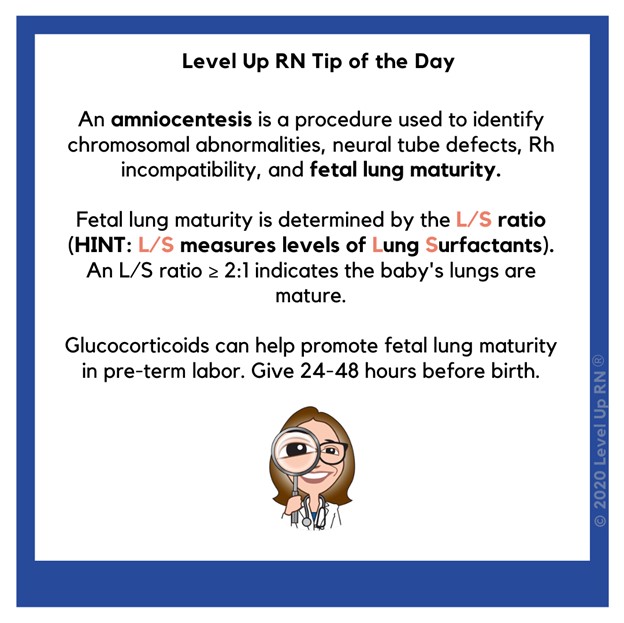A nurse is performing an external nonstress test for a client who is at 41 weeks of gestation and has oligohydramnios.
The nurse notes that there are no accelerations in the fetal heart rate tracing after applying an acoustic stimulator to the maternal abdomen for several seconds.
Which of the following actions should the nurse take?
Repeat the acoustic stimulation after 1 minute
Document the finding as a nonreactive NST
Perform a contraction stress test (CST)
Notify the provider and prepare for delivery
The Correct Answer is D
Notify the provider and prepare for delivery. Oligohydramnios is a condition where the amniotic fluid volume is less than expected for gestational age and it is associated with maternal and fetal complications.
The nonstress test (NST) is a method of fetal surveillance that measures the fetal heart rate response to fetal movement. A reactive NST is defined as at least two accelerations of 15 beats per minute or more above the baseline, lasting 15 seconds or more, within a 20-minute period.
A nonreactive NST indicates fetal hypoxia or acidosis and requires further evaluation. An acoustic stimulator can be used to elicit fetal movement and accelerations, but it should not be repeated more than once in a 10-minute period.
Therefore, choice A is wrong because repeating the acoustic stimulation after 1 minute is too soon and may cause fetal distress.
Choice B is wrong because documenting the finding as a nonreactive NST is not enough to address the situation. Choice C is wrong because performing a contraction stress test (CST) is contraindicated in oligohydramnios because it may cause umbilical cord compression and fetal compromise.
The CST involves inducing uterine contractions with oxytocin or nipple stimulation and monitoring the fetal heart rate for signs of intolerance.
A negative CST means that there
Nursing Test Bank
Naxlex Comprehensive Predictor Exams
Related Questions
Correct Answer is B
Explanation
Lecithin/sphingomyelin (L/S) ratio.
This is a test that measures the amount of two phospholipids in the amniotic fluid that are important for the production of surfactant, a substance that helps the lungs expand and prevents them from collapsing.A higher L/S ratio indicates more surfactant and greater fetal lung maturity.The normal range for L/S ratio is 2:1 or higher at term.

Choice A is wrong because alpha-fetoprotein (AFP) is a protein produced by the fetus that can be measured in the amniotic fluid or maternal blood.It is used to screen for neural tube defects and other abnormalities, not for fetal lung maturity.
Choice C is wrong because Kleihauer-Betke test is a blood test that detects fetal red blood cells in the maternal circulation.It is used to diagnose fetomaternal hemorrhage, a condition where fetal blood leaks into the mother’s blood, not for fetal lung maturity.
Choice D is wrong because indirect Coombs’ test is a blood test that detects antibodies in the mother’s blood that may attack the fetal red blood cells.It is used to screen for Rh incompatibility or other blood group sensitization, not for fetal lung maturity.
Correct Answer is D
Explanation
Notify the health care provider.Late decelerations are a sign of uteroplacental insufficiency, which means that the blood flow and oxygen supply to the placenta and the fetus are compromised.This is a serious condition that can lead to fetal hypoxia and acidosis.The priority nursing intervention is to inform the health care provider who can assess the situation and decide on the appropriate course of action, such as delivery by cesarean section.
Choice A is wrong because changing the client’s position may not improve the blood flow to the placenta if there is a problem with the placenta itself, such as placental abruption.
Choice B is wrong because administering oxygen via face mask may not be enough to correct the fetal hypoxia caused by uteroplacental insufficiency.
Choice C is wrong because increasing intravenous fluid rate may not improve the blood flow to the placenta if there is a problem with the maternal blood pressure, such as hypotension from epidural analgesia.
Whether you are a student looking to ace your exams or a practicing nurse seeking to enhance your expertise , our nursing education contents will empower you with the confidence and competence to make a difference in the lives of patients and become a respected leader in the healthcare field.
Visit Naxlex, invest in your future and unlock endless possibilities with our unparalleled nursing education contents today
Report Wrong Answer on the Current Question
Do you disagree with the answer? If yes, what is your expected answer? Explain.
Kindly be descriptive with the issue you are facing.
